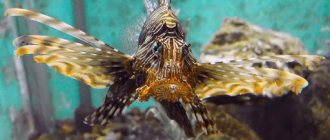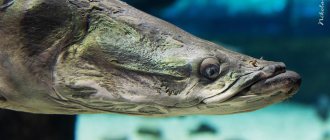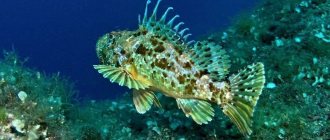The ocean seems endless, scientists continue to discover more and more new species of fish. Some of them are touching, while others make you horrified. And if we already wrote about the most beautiful fish once, today we want to talk about the most terrible fish in the world.
We've picked up a few fish with such a terrifying appearance that after reading our article, you'll think twice before getting into the water. Of course, some of the fish on the list are found in small regions, but the ocean has no boundaries and its depths have never been explored, who knows what else you might encounter. Already scared? Let's consolidate our success and finally show these monsters.
10
Lionfish
The lionfish is an inhabitant of warm waters in the Red Sea. It can often be found among coral reefs in shallow waters. Its appearance at first glance may not seem as ugly as the appearance of the terrifying fish that live in the depths of the ocean, but the structure of the lionfish’s body will definitely cause a feeling of danger, because it is poisonous. Body structure:
- Along the entire circumference of the lionfish’s body there are several sharp fins in different places, and on their surface there are poisonous glands, which are dangerous for humans and animals.
- There are about 30 such poisonous fins on the lionfish. The lionfish is easy to recognize from afar in the upper layer of water, which is clearly visible in the light, because it looks like a bright striped object with white and reddish stripes.
But the danger is that the appearance of the lionfish fits quite naturally into the colorful marine vegetation and colors of coral reefs. This allows her to easily camouflage herself from danger and unexpectedly overtake the victim.
Young lionfish are completely colorless and almost invisible, but their fins contain no less poison than an adult, which makes them doubly dangerous and invulnerable.
Yandex pictures
The most terrible inhabitants of the sea abyss
These animals hide at various ocean depths. Photos and videos of the inhabitants of the seabed may surprise you.
1. Shark lizard
This shark lives thousands of meters below the surface of the water, but sometimes it surfaces. Perhaps to remind us how unusual the inhabitants of the ocean are. This rarely seen shark inhabits the depths of the Atlantic and Pacific oceans. Scientists believe that it catches its prey by bending its body and lunging forward, like a snake when attacking, to swallow the victim whole.
2. Deep-sea eel with a mouth like a pelican
An eel with a pelican's head. You can meet this creature at a depth of about one thousand meters; its body length reaches two meters. Bigmouth is probably one of the strangest looking deep sea creatures lurking in the depths of the ocean. With a huge mouth, the pelican is capable of swallowing things much larger than its own size.
3. Saberfish
Despite having such an aggressive-sounding name (its teeth, in proportion to its body, are the largest of any ocean creature), the Sabretooth is quite small and harmless to humans. Horrifying looking, but safe. This is one of the deepest sea animals. A fish with monstrous fangs was discovered at a depth of more than 5,000 meters, where the pressure is 500 times higher than on Earth. A person in such conditions would be flattened like a pancake.
4. Viperfish from the Pacific Ocean
While during the day the viper fish remains in the depths, at night it moves to shallower territory, often getting caught in the nets of sea fishermen. They do not survive in captivity, but this way they were studied in more detail. With its appearance, the viper fish fully deserves a place on the list of sea monsters. The Pacific viperfish lives at depths of over one thousand meters and attracts prey with an insidious light.
5. Monkfish
Named for its methods of searching for prey, the anglerfish, or monkfish, uses a fleshy appendage protruding from the top of its head as bait to attract its prey. The monkfish lives at a depth of 2000 meters and attracts its prey in a similar way, using light, like the viper fish. The only difference is that the strange glowing antenna comes out of his head. This makes him look like the scary predator from the cartoon Finding Nemo.
6. Stargazer fish or seabird
The astrologer buries itself in the sand and waits for its prey. Its head always remains up and its eyes look up, and its body structure is ideal for this hunting technique. These fish make their way underground in the sand and leap upward to attack their prey as it swims by. In addition, some varieties are electric and are capable of shocking the victim.
7. Giant Spider Crab
This is the largest crab existing on the planet. It lives approximately 300 meters below sea level, and its claws grow over three meters long.
8. Giant isopod
You can see this arthropod with a 30-centimeter body at a level of more than 2000 meters under water. First and foremost, he is a scavenger with a ferocious appetite.
9. Goblin shark or goblin shark
Little is known about this deep sea creature, as only a few specimens have ever been caught by fishing boats, but those rare sightings have been enough to earn it a fearsome reputation. With a prominent snout and retractable jaws, the goblin shark's physical characteristics are worthy of its name. The goblin shark reaches up to 3.5 meters in length and lives more than 1,300 meters below the sea surface.
10. Giant squid Architeuthis
Rarely seen by humans, the giant squid has become the stuff of legends over the centuries. It lives deep underwater, its only real enemy is the sperm whale. In fact, these two giants are known for their deep sea battles, and their bodies are often found with signs of mortal combat. The length of this giant squid reaches 18 meters, which is equivalent to a six-story building.
11. Blind lobster Dinochelus ausubeli
This lobster was discovered only in 2007 in the depths of the ocean near the Philippines.
12. Large Mouth Shark
Since its discovery in 1976, this extremely rare species of deep-sea shark has rarely been spotted by humans and there is as yet no agreement in the scientific community on how to actually classify it. The most distinctive feature is its gaping mouth, which the largemouth shark uses to swallow plankton and fish. The pelagic largemouth shark grows up to 5.5 meters, and the rare deep-sea animal feeds on plankton.
13. Giant marine polychaete worm
The length of an adult predator can reach an incredible 2-3 meters, and its appearance will make you truly horrified.
14. Dragon fish
Despite the fact that it lives at depths of almost two kilometers, the dragon fish is born from eggs actually on the surface of the ocean. Like many other deep-sea creatures, she eventually becomes capable of creating her own light, using a technique known as bioluminescence, and then retreats into the depths. One of the many light-emitting photophores can be found on the barbel attached to the lower jaw, which the dragonfish most likely uses to search for food.
15. Vampire Squid
With the largest eyes (in proportion to its body) of any animal in the world, this deep sea creature is born to live in the depths. And despite the name, the vampire does not suck blood; in fact, its tentacles do not have suction cups. The squid's name comes from its intensely red eyes and cape.
16. Big red jellyfish
This amazingly large jellyfish can grow over one meter in length and has a distinctive red coloration. Instead of tentacles, the deep sea jellyfish uses a series of fleshy “arms” to capture its prey.
17. Drop fish
Primarily found in the deep waters off Australia and New Zealand, the blobfish lives at depths of more than 1,200 meters. The pressure here is several dozen times higher than at the surface, so its body is a gelatinous mass.
18. Coffin fish
Resembling a pink hot air balloon, these deep sea hunters are something of a cross between a dogfish and a monkfish. Although they lure their prey using bloat, they also transform into a ball when threatened.
19. Chimera fish
Not to be confused with the chimera of Greek mythology, these creatures are also known as phantom sharks, and although they live in all layers of the oceans, today they are mainly limited to the deep sea level.
20. Amphipod
Although these tiny crustaceans are usually no larger than an inch, in the depths of the Pacific Ocean floor, about 6 kilometers from the surface, they can grow up to 30 centimeters in length.
21. Dumbo the Octopus
Named after the elephant in the Disney film, this octopus isn't quite as terrifying as the frillied shark, but it looks just as scary from the outside.
22. Snaggletooth
There's no way to describe this deep sea creature without using some "very ugly" words. Like several other species on this list, due to living in such depths, the snaggletooth is capable of creating its own light and uses this ability to search for prey.
23. Axefish
To avoid confusion with the freshwater carnegiella found in many home aquariums, this species is named for its distinctive axe-shaped body shape. Living at extreme depths, the fish has two tubular eyes that point upward to make it easier to catch food coming from above.
24. Opisthoproct
Also known as ghost fish, these strange-looking creatures are similar to hatchet fish in that they have two upward-pointing eyes to better locate prey. Their distinguishing feature, however, is their transparent head.
25. Grenadier fish
One of the more prominent deep sea inhabitants, the grenadier is estimated to make up about 15 percent of the deep sea population. Grenadiers can be found at depths greater than 6 kilometers; there are few other creatures that can survive in such a hostile environment.
26. Blue-ringed octopuses
Although it may not look as physically imposing as some of the other creatures on this list, the blue-ringed octopus is one of the most dangerous animals in the ocean. Its poison is extremely powerful and there is no antidote for it.
27. Black Crookshanks
The Black Crookshank is famous for its ability to swallow prey that is much larger than itself. It is small in size, but can actually swallow prey ten times its own weight.
Based on materials from: cameralabs.org, LifeGlobe
Placoderms
Placoderms are already extinct fish that have not yet been discovered in the modern world, but in the future everything is possible given that the ocean is 7% explored.
The placoderm specimen belongs to the class of jawed fish that lived on earth more than 200 million years ago. They were truly frightening in their appearance: a hard, almost petrified surface of the body from the end of the tail to the head, which protected them from more dangerous predators, hard and massive jaws that could easily kill weaker fish.
It’s good that they died out so long ago, because who knows what the revolution would have led to. Suddenly placoderms would become even more dangerous and impressive in size. In this scenario, the ocean would be even more dangerous for both its inhabitants and humans.
Yandex pictures
Giant isopod (Bathynomus giganteus)
The giant isopod, known to science as Bathynomus giganteus, is the largest species of crustacean. The average size of a deep-sea isopod ranges from 30 centimeters, but the largest recorded specimen weighed 2 kilograms and was 75 centimeters long. In appearance, giant isopods are similar to woodlice, and like the giant squid, they are a consequence of deep-sea gigantism. These crayfish live at a depth of 200 to 2500 meters, preferring to bury themselves in silt.
The body of these creepy creatures is covered with hard plates that act as a shell. In case of danger, crayfish can curl into a ball and become inaccessible to predators. By the way, isopods are also predators and can feast on a few small deep-sea fish and sea cucumbers. Powerful jaws and durable armor make the isopod a dangerous opponent. Although giant crayfish love to feast on live food, they often have to eat the remains of shark prey that fall from the upper layers of the ocean.
Pufferfish
Puffer fish are a family that differ from other individuals in their ability to change body shape, high toxicity and sharp, numerous teeth. There are more than 200 different individuals in the world. The most striking representatives are the fugu fish and the star-shaped pufferfish, which can reach more than a meter in size. Puffer fish are especially dangerous when they sense danger: they immediately swell and release their poisonous teeth and spines, which makes them creepy and dangerous creatures.
Yandex pictures
Electric eel
- Maximum length : 250 cm
- Maximum weight : 20 kg
Nature has given the electric eel a special way of survival. It produces up to 600 volts of electrical current, which is enough to kill a person or any other living thing. This is undoubtedly one of the deadliest fish in the world. In addition, eels can live on average up to 150 years.
Vampire fish
The vampire fish has this name for a reason. Her sharp and long teeth on the lower jaw, curved in the opposite direction, create... On the surface of the earth, it can be compared to a saber-toothed tiger, which also has terrifying front fangs, emphasizing its dominance over other animals. The vampire fish lives in the waters of the Amazon River, easily piercing other fish with its terrible teeth.
Yandex pictures
Stargazers
The second name for these fish is seaweed. Their terrible features are largely explained by their lifestyle. Stargazers are active in the dark, and during the day they burrow into the sand, leaving only their mouth and eyes on the surface in order to see prey and be able to grab it. They usually live in the seas and warm waters of the Atlantic, Indian and Pacific oceans. Sometimes found at the mouths of rivers flowing into the seas. Seabugs are not only scary fish, but also poisonous. They have a spine that secretes venom glands, although some scientists question this idea. They can also produce electric current charges reaching 50V.
By the way, on our website most-beauty.ru you can also look at amazing sea inhabitants, so similar to alien creatures.
5
Stargazers
Stargazer fish live in the upper layers of water. What makes this fish disgusting is the structure of its head and its main distinguishing features:
- the head looks flattened, and there are horny plates on its surface
- eyes seem to completely fall out of their sockets
- the stargazer's muzzle has a dissatisfied expression due to the elongated upper jaw and shortened lower jaw
- the mouth along the contour is covered with lips, somewhat reminiscent of a fringe. This mouth is designed to filter water.
All these far from attractive facial features make the fish ugly, but it is worth remembering that it is also dangerous.
Yandex pictures
Clowns
Clown fish are distinguished by their bright colors in the form of a combination of two colors: orange and black. For some they are beautiful, while others, on the contrary, consider the combination of such bright colors ugly. But the clown fish is definitely not included in the concept of scary fish. Each individual from the clownfish family is capable of quickly gaining speed and overtaking prey in a matter of seconds.
Yandex pictures
Asian sheephead wrasse
What gives this fish a terrible appearance is its head, which is similar in features to a human one. The growths on the forehead and chin give it a humanoid appearance. An interesting fact is that wrasses can change their sex if one sex is not sufficient for reproduction. You can meet these extraordinary creatures in the waters near the Japanese islands.
Yandex pictures
Redfin opah
From the point of view of its appearance, the red-tipped opah (Lampris guttatus) will surprise few people. You may have seen these fish in large aquariums. What makes the redfin opah a truly unusual fish is not on the outside, but on the inside: it is the first identified species of warm-blooded fish, that is, it is independently capable of maintaining its internal body temperature 10 ° C above the temperature of the surrounding water. This unique physiology gives the redfin opah greater energy (they are known to migrate thousands of kilometers) and also supports them in extreme deep-sea habitats. The hard question is, if warm-blooded metabolism is a beneficial adaptation, then why are other fish cold-blooded?
frilled shark
This species of shark is unusual for its long, strong body with an elongated tail fin. At first glance, it may seem that this fish is an eel. The body is painted a uniform dark brown color, and the abdomen has folds and wrinkles. This shark’s terrifying and frightening appearance is given not only by its elongated snake-like body, but also by its short, flat muzzle.
Yandex pictures
European anglerfish
Another name is European monkfish. The head is decorated with a fishing rod, with a bait flashlight at the end.
The anglerfish looks ugly. Large teeth and a head with bulging eyes, a small tail, a scaleless brown body with lumpy growths. In the photo you can see the resemblance to driftwood.
Mating occurs in a special way. Researchers had difficulty identifying males. The usual-looking individuals with a fishing rod are females. The male sex is much smaller in size and exists thanks to its ladies. By digging their teeth into the female’s body, the males grow larger, and all organs atrophy. The couple's circulatory systems are connected. Feeding occurs at the expense of the female, while the male fertilizes the eggs.
The anglerfish lives in the coastal area. It lies in wait for the victim, hiding in the sand. This fish is not dangerous for humans. But an accidental touch disturbs the peace. In response, the culprit will be struck with a sharp bite.
Anglerfish meat has a very delicate taste and is classified as a delicacy.
Blob fish
An unusual blob fish lives in the deep waters of the ocean. In her appearance you can see completely different emotions. She is at the same time funny and amusing, sad and unhappy. The blobfish belongs to the psycholute fish population, which is not numerous. The fish was named drop based on its body shape, which looks like a jelly substance. The fish was first discovered near the island of Tasmania in the 20s of the 20th century. The fish is still poorly studied due to its inaccessibility.
Due to the enormous depth, it is almost impossible to trace its life activity in its natural habitat.
Yandex pictures
Giant squid (Architeuthis dux)
The elusive giant squid, known to science as Architeuthis dux, is the world's largest mollusc and is thought to reach a length of 18 meters and weigh half a ton. To date, a live giant squid has never been captured by humans. Until 2004, there were no documented cases of encountering a living giant squid, and the general idea of these mysterious creatures was formed only from the remains washed ashore or caught in fishermen’s nets. Architeuthis live at depths of up to 1 kilometer in all oceans. In addition to their gigantic size, these creatures have the largest eyes among living creatures (up to 30 centimeters in diameter).
So in 1887, the largest specimen in history, 17.4 meters long, washed up on the shores of New Zealand. In the next century, only two large dead representatives of the giant squid were discovered - 9.2 and 8.6 meters. In 2006, Japanese scientist Tsunami Kubodera managed to capture on camera a living female 7 meters long in her natural habitat at a depth of 600 meters. The squid was lured to the surface by a small bait squid, but an attempt to bring a live specimen on board the vessel was unsuccessful - the squid died from multiple injuries.
Giant squids are dangerous predators, and their only natural enemy is adult sperm whales. There are at least two described cases of fight between squid and sperm whale. In the first, the sperm whale won, but soon died, suffocated by the giant tentacles of the mollusk. The second fight took place off the coast of South Africa, then a giant squid fought with a baby sperm whale, and after an hour and a half fight, it still killed the whale.
White shark
The great white shark is known to every person and poses a great danger in open ocean waters, both for ocean inhabitants and for people who swim and dive. The white shark is the most dangerous predator in the ocean. Its powerful and agile body structure allows it to easily overtake prey and immediately absorb it. Body structure:
- 300 sharp teeth, consisting of several rows
- an adult can reach 5 meters
- females are often larger than males
- there is a sharp, strong fin on the back and tail.
Yandex pictures
Gunch
The fish, found in the warm rivers of India and Nepal, has a second name - devilish catfish. It has an aggressive character and huge size, often attacks people. Cases of devilish catfish hunting people have been recorded: after an attack, the fish drags the person under water.
Read also: muted blue IN COLOR BALANCE
Long-horned sabertooth
The longhorned sabertooth is small in size compared to several previously discussed scary fish. Its length is only 15 cm. The body of the saber-tooth is black in color, elongated in structure, and the head is massive and occupies about 30% of the body. Its most dangerous and terrible part is its teeth, which are shaped like sabers. On the lower jaw there are 2 long sharp fangs. There are also 2 fangs on the upper jaw, but of a smaller size. A potential victim of a long-horned sabertooth will be defeated in a matter of seconds by sharp teeth that pierce right through the bodies of weaker fish.
Yandex pictures
Brownie shark
The shape of the goblin shark resembles a real goblin, but in a more creepy variation. Its head is an elongated flat snout, resembling a shovel and protruding strongly from the main body, which is more similar to a typical fish body. The fish has a translucent pink skin texture through which you can even see the blood vessels.
The most frightening and repulsive fact in its life: when a shark rises sharply from a low depth to the upper layer of water, its skin begins to turn red, its insides are visible from its mouth, and its eyes strive to leave their sockets
Yandex pictures
Coelacanth
Coelacanth belongs to the ancient order Coelacanths. Coelacanth is a prehistoric fish and living fossil, the study of which can reliably study the characteristics of this species. What makes it frightening and unusual is the specific shape of the skull, which no other fish has, because coelacanth is the only surviving example of a prehistoric specimen of this species of its kind. The body color is dark gray with blue tints and numerous light gray spots. This coloring makes it easy to camouflage from predators in caves among tunicates that have similar colors.
Yandex pictures
Meshkorot
Its shape resembles an iron. The name of this sea monster is associated with its wide-opening, vile mouth. There he is able to place prey that is larger than the predator itself. The stomach is also gigantic in size. Body length is about 2 meters. Habitat depth is 2-5 km.
Very similar to the largemouth bagmouth. Their body is slightly shorter, from half a meter to a meter. The tail is equipped with a flickering pink light, which is characteristic of deep-sea fish. This is how they lure prey.
Angler
Anglerfish live deep at the bottom, where they burrow into the ground, protecting themselves from predators and other dangers. Individual individuals can live in underwater vegetation or among scattered rocks and rocks. The look of the monkfish is truly devilish:
- dark body covered with bony growths and formations
- flattened body shape
- small eyes located far away on the head
- sharp teeth and fringe-like outgrowths on the fins
- adult individuals are capable of reaching sizes of 1-1.5 meters.
Yandex pictures
Viper fish
The snake-like fish reaches a length of 30-35 cm and is similar to a viper, but is distinguished by a stronger, resourceful body and large sharp teeth, which are dangerous for potential victims. Round eyes have a convex shape and are located on the sides of the head. Viper fish live in deep waters, which makes research about their life activities impossible, so many aspects of their life remain a mystery.
This species belongs to the genus Howloids and consists of 6 similar species.
Yandex pictures
Ugly
Scary fish on the ocean floor can scare anyone. Fortunately, so far only divers, known to have strong nerves, can see them at arm's length. Anglerfish live in places where the sun's rays cannot penetrate. They are called the ugliest of sea creatures. As if ashamed of their appearance, they lead a bottom existence. They burrow into the sand and wait for prey. They look scary.
On the huge head, cut by a wide mouth, there are ugly spikes. The fish's teeth are not only sharp, but also curved inward. If you meet such a monster in the darkness of the sea, you might get a heart attack. These monsters grow up to two meters in length. In addition, their color is gray or brown, so it is impossible to notice them from a distance. In order not to offend an innocent creature, it must be said that the names of deep-sea fish themselves can be frightening. So, among these creatures there is a sack-eater and a sack-eater! What about a sea slug or sabertooth? The imagination suggests all sorts of horrors.
Wart (stone fish)
The wart is the most poisonous fish. It can kill a person by spraying large quantities of poison onto the surface or inside the skin. Victims of this fish claim that the pain from the penetration of its poison is so severe that they have to amputate the damaged part of the body. The stone fish adapts well to its environment and often lies in the sand, creating a strong danger for those who may accidentally step into its location.
Yandex pictures
Astrologer
Also called sea cow. She was named that way because of her facial expression. High-set eyes are located on the top of the head at a close distance from each other. The mouth is open, as if amazed. In the photo, the fish looks stunned, as if looking for something in the sky. What makes the fish look ugly is the fringe on its mouth. This is necessary for garbage filtering to occur.
The bait is hidden in the mouth - a red worm, which resembles a respiratory membrane. The approaching prey reacts to the bait that the stargazer throws out. So there is no need to even move in search of food. This is a slow fish and spends most of its time lying on the bottom, buried in the sand. But still, the astrologer is not so slow. It can make quick, sharp jerks, biting into its prey. The body also has poisonous spikes and a stun gun.
For a person, a collision with this fish can be fatal. Fatal cases have been recorded around the world.
Big tiger fish
The Goliath tiger fish is called the African piranha, which can compete even with crocodiles:
- in size it reaches 2 meters
- in its mouth there are 32 sharp teeth 3-4 cm long
- has a characteristic brindle color
The strong body structure of this fearsome fish allows it to swim against the current of turbulent African waters. It is precisely in a stormy stream that she hunts, intercepting prey. The fish successfully hunts reptiles and even eats birds that come even slightly close to the surface of the water.
Yandex pictures
Box jellyfish
- Maximum diameter : 30 cm
- Maximum length : 20 cm
- Maximum tentacle length: 300 cm
- Maximum weight : 2 kg
Box jellyfish are different from other members of their family in a number of ways, as they have a more developed nervous system and multiple pairs of eyes. The epidermis covering the tentacles contains batteries of stinging cells with which box jellyfish kill their victims. Box jellyfish venom can cause death within minutes as it paralyzes the heart. They are found in almost all tropical and subtropical waters with oceanic salinity.
Vampire characin
The vampire characin with massive and sharp teeth on the front of the jaw lives in the waters of the Amazon, where it successfully hunts other fish, piercing them with its sharp fangs. They grow up to 1.5 m, but weigh little, only 14 kilograms. The fangs, thanks to which the fish was called both a vampire and a characin at the same time, can reach 16 cm in size.
Yandex pictures
When hunting, the predator immediately pierces the internal organs of the prey, and with the help of the remaining teeth, dismembers it and consumes it.











